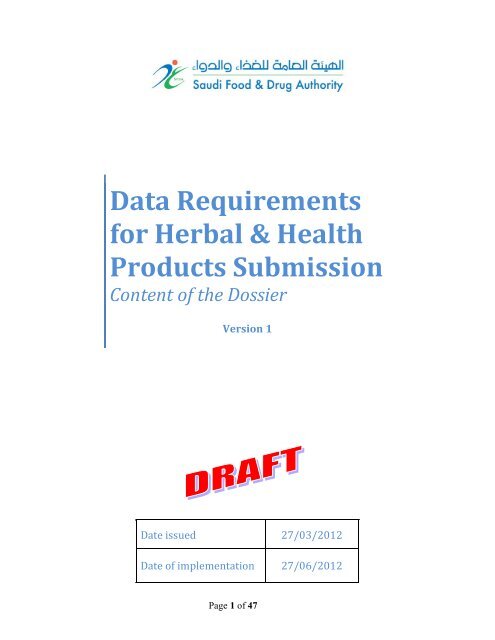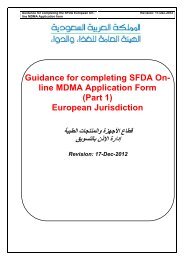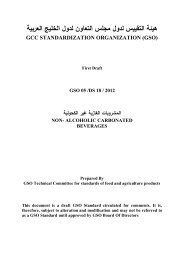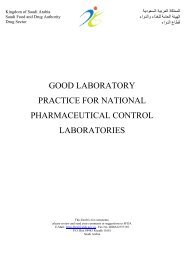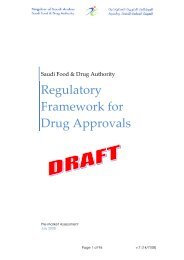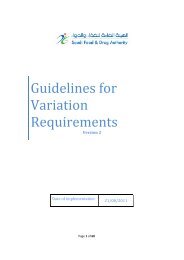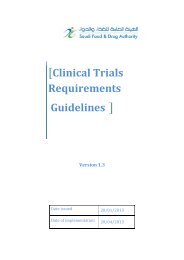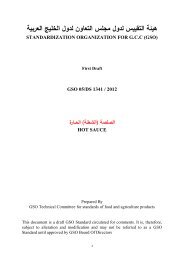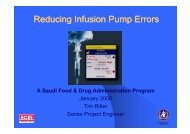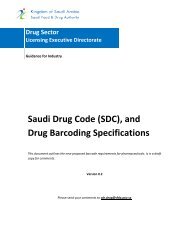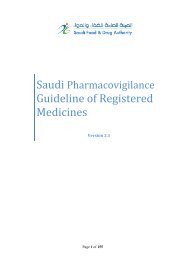Data Requirements for Herbal and Health products submission
Data Requirements for Herbal and Health products submission
Data Requirements for Herbal and Health products submission
You also want an ePaper? Increase the reach of your titles
YUMPU automatically turns print PDFs into web optimized ePapers that Google loves.
Document ControlVersion Date Author(s) Comments1.0 27/03/2012Product Evaluation <strong>and</strong> St<strong>and</strong>ardsSetting Executive DirectorateDraft.Page 3 of 47
3.2.S.3.1 Elucidation of Structure <strong>and</strong> Other Characteristics R3.2.S.3.2 Impurities R3.2.S.4Control of Drug Substance3.2.S.4.1 Specifications R3.2.S.4.2 Analytical Procedures R3.2.S.4.3 Validation of Analytical Procedures R3.2.S.4.4 Batch Analyses R3.2.S.4.5 Justification of Specification R3.2.S.5 Reference St<strong>and</strong>ards or Materials R3.2.S.6 Container/Closure Systems R3.2.S.7Stability3.2.S.7.1 Stability Summary <strong>and</strong> Conclusions R*3.2.S.7.2 Post-approval Stability Protocol <strong>and</strong> Commitment R*3.2.S.7.3 Stability <strong>Data</strong> R*3.2.PDrug Product3.2.P.1 Description <strong>and</strong> Composition of the Drug Product R3.2.P.2Pharmaceutical Development3.2.P.2.1Components of the Drug Product3.2.P.2.1.1 Drug substance(s) R3.2.P.2.1.2 Excipients R3.2.P.2.2Drug Product3.2.P.2.2.1 Formulation Development R3.2.P.2.2.2 Overages R3.2.P.2.2.3 Physiochemical <strong>and</strong> Biological Properties R3.2.P.2.3 Manufacturing Process Development R3.2.P.2.4 Container Closure System R3.2.P.2.5 Microbiological Attributes R3.2.P.2.6 Compatibility IA3.2.P.3Manufacture3.2.P.3.1 Manufacturer(s) R3.2.P.3.2 Batch Formula R3.2.P.3.3 Description of Manufacturing Process <strong>and</strong> Process Controls R3.2.P.3.4 Controls of Critical Steps <strong>and</strong> Intermediates R3.2.P.3.5 Process Validation <strong>and</strong>/or Evaluation R3.2.P.4Control of Excipients3.2.P.4.1 Specifications R3.2.P.4.2 Analytical Procedures R3.2.P.4.3 Validation of Analytical Procedures R3.2.P.4.4 Justification of Specifications R3.2.P.4.5 Excipients of Human or Animal Origin R3.2.P.4.6 Novel Excipients R3.2.P.5Control of Drug Product3.2.P.5.1 Specifications R3.2.P.5.2 Analytical Procedures R3.2.P.5.3 Validation of Analytical Procedures R3.2.P.5.4 Batch Analyses RPage 8 of 47
3.2.P.5.5 Characterization of Impurities IA3.2.P.5.6 Justification of Specifications R3.2.P.6 Reference St<strong>and</strong>ards or Materials R3.2.P.7 Container/Closure System R3.2.P.8Stability3.2.P.8.1 Stability Summary <strong>and</strong> Conclusions R3.2.P.8.2 Post-Approval Stability Protocol <strong>and</strong> Stability Commitments R3.2.P.8.3 Stability <strong>Data</strong> R3.3 Literature References RModule 4Non-Clinical Study Reports4.1 Table of Contents of Module 4 R4.2 Study Reports IA4.3 Literature References RModule 5Clinical Study Reports5.1 Table of Contents of Module 5 R5.2 Tabular Listing of All Clinical Studies IA5.3 Clinical Study Reports IA5.4 Literature References RR*: <strong>for</strong> more details, refer to the explanation in section (3.2.S.7)Page 9 of 47
Module 1Regional Administrative In<strong>for</strong>mation1. Cover letterThe applicant shall include a cover letter <strong>for</strong> each <strong>submission</strong>. A template is provided in theSFDA Guidance <strong>for</strong> Submission (http://www.sfda.gov.sa/En/Drug/Topics/Regulations+-+Guidelines.htm).1.1. Comprehensive table of contentThe table of content <strong>for</strong> the entire <strong>submission</strong> should list all documents included in all Modules.1.2. Application FormThe completed <strong>and</strong> signed application <strong>for</strong>m printed out from the Saudi Drug Registration (SDR)system (https://sdr.sfda.gov.sa/frmLogin.aspx) should be presented in this section.1.3. Product In<strong>for</strong>mationThis section contains the Summary of Product Characteristics (SPC), Labeling, PatientIn<strong>for</strong>mation Leaflet (PIL) in Arabic <strong>and</strong> English, Artwork <strong>and</strong> the Samples.1.3.1. Summary of Product Characteristics (SPC)The SPC should include the name of the product, strength, pharmaceutical <strong>for</strong>m, quantity ofactive ingredients, posology, method of administration, indications, contraindications, excipients,shelf-life <strong>and</strong> any special warnings <strong>and</strong> precautions <strong>for</strong> use … etc.Refer to the GCC Guidance <strong>for</strong> Presenting the SPC, PIL <strong>and</strong> Labeling In<strong>for</strong>mation(http://www.sfda.gov.sa/En/Drug/Topics/Regulations+-+Guidelines.htm).1.3.2. LabelingThe labeling <strong>for</strong>ms part of the authorization of the product <strong>and</strong> must there<strong>for</strong>e be approved by theSFDA. The text of the labeling must be in compliance with the SPC.Refer to the GCC Guidance <strong>for</strong> Presenting the SPC, PIL <strong>and</strong> Labeling In<strong>for</strong>mation(http://www.sfda.gov.sa/En/Drug/Topics/Regulations+-+Guidelines.htm).Page 10 of 47
1.3.3. Patient In<strong>for</strong>mation Leaflet (PIL)1.3.3.1. Arabic leaflet1.3.3.2. English leafletThe Patient In<strong>for</strong>mation Leaflet (PIL) <strong>for</strong>ms part of the authorization of the product <strong>and</strong> mustthere<strong>for</strong>e be approved by the SFDA. The text of the PIL must be in compliance with the SPC.The application <strong>for</strong> a marketing authorization must include a draft <strong>for</strong> the PIL.Refer to the GCC Guidance <strong>for</strong> Presenting the SPC, PIL <strong>and</strong> Labeling In<strong>for</strong>mation(http://www.sfda.gov.sa/En/Drug/Topics/Regulations+-+Guidelines.htm).1.3.4. Artwork (Mock-ups)A mock-up is a flat artwork design in full color, presented so that, following cutting <strong>and</strong> folding,where necessary, it provides a full size replica of both the outer <strong>and</strong> immediate packaging so thatthe two dimensional presentation of the label text is clear.The application <strong>for</strong> a marketing authorization must include one or more mock-ups of the outerpackaging <strong>and</strong> of the immediate packaging of the product.Refer to the GCC Guidance <strong>for</strong> Presenting the SPC, PIL <strong>and</strong> Labeling In<strong>for</strong>mation(http://www.sfda.gov.sa/En/Drug/Topics/Regulations+-+Guidelines.htm).1.3.5. SamplesA number of samples should be provided in order to per<strong>for</strong>m complete testing. The requiredquantities of samples is further described in the SFDA Guidance <strong>for</strong> Submission(http://www.sfda.gov.sa/En/Drug/Topics/Regulations+-+Guidelines.htm).The submitted samplesmust represent the final finished product to be marketed in Saudi Arabia.1.4. In<strong>for</strong>mation on the experts1.4.1. Quality1.4.2. Non-Clinical1.4.3. ClinicalPage 11 of 47
It is important to emphasize that well prepared expert reports greatly facilitate the task of theSFDA in evaluating the dossier <strong>and</strong> contribute towards the speedy processing of applications.Authors of expert reports must be chosen on the basis of their relevant qualifications <strong>and</strong> theirrecognized expertise in the field concerned. The experts should preferably not have beenpersonally involved in the conduct of the tests included in the dossier.Each expert report should consist of:• An abbreviated product profile;• A critical evaluation of the dossier;• The opinion of the expert as to whether sufficient guarantees have been provided as to thesuitability of the product <strong>for</strong> its proposed use;• A summary of all the important data;• The signature of the expert <strong>and</strong> the place <strong>and</strong> date of the report’s issue;• The expert’s curriculum vitae <strong>and</strong> a declaration of the expert’s professional relationshipto the applicant.It is essential to note that the expert reports must include a critical discussion of the properties ofthe product as demonstrated by the contents of the dossier. The expert is expected to take <strong>and</strong>defend a clear position on the final product, in the light of current scientific knowledge. A simplefactual summary of the in<strong>for</strong>mation contained in the application is not sufficient <strong>and</strong> the expertreports must not be a repetition of other parts of the dossier, although important data will need tobe summarized in the expert report in some <strong>for</strong>m. Both expert reports <strong>and</strong> summaries mustcontain precise references to the in<strong>for</strong>mation contained in the main documentation. If expertswish to supplement their report by reference to additional literature, they must indicate clearlythat the applicant has not included this in<strong>for</strong>mation in the relevant part of the dossier.1.5. Environmental Risk Assessment1.5.1. Non-Genetically Modified Organism (Non-GMO)1.5.2. GMOThe applicant shall include an evaluation <strong>for</strong> any potential risks of the product to theenvironment. This should include risks to the environment arising from use, storage <strong>and</strong> disposalof <strong>products</strong> <strong>and</strong> not <strong>for</strong> risks arising from the synthesis or manufacture of <strong>products</strong>.Page 12 of 47
1.6. Pharmacovigilance1.6.1. Pharmacovigilance SystemIt shall contain a detailed description of the pharmacovigilance system including the proof thatthe applicant has the services of a qualified person responsible <strong>for</strong> pharmacovigilance <strong>and</strong> thenecessary means <strong>for</strong> the notification of any adverse reaction. The detailed description of thepharmacovigilance system that the applicant should include it in this section is described in theSaudi pharmacovigilance guideline of registered medicines (http://www.sfda.gov.sa/NR/rdonlyres/6C3D8558-8406-45F6-88BF-121B9F1B2373/0/SaudiPharmacovigilanceGuidelineofRegisteredMedicines_2011.pdf).1.6.2. Risk Management PlanA detailed description of the risk management system which the applicant will introduce shouldbe provided, where appropriate. The detailed description of a risk management system should besubmitted in the <strong>for</strong>m of SFDA Risk Management Plan (SFDA-RMP), as outlined in the Saudipharmacovigilance guideline of registered medicines (http://www.sfda.gov.sa/NR/rdonlyres/6C3D8558-8406-45F6-88BF-121B9F1B2373/0/SaudiPharmacovigilanceGuidelineofRegisteredMedicines_2011.pdf).1.7. Certificates <strong>and</strong> Documents1.7.1. GMP CertificateA valid GMP Certificate should be submitted.1.7.2. CPP or Free-salesThe CPP should be in accordance with WHO guidelines. However, if the CPP is not available, amarketing authorization (or free sales certificate) from the country of origin (COO) should besubmitted. Marketing authorization (or free sales certificate) should include the following:1. Product trade name in the COO.2. Number <strong>and</strong> date of marketing authorization in the COO.3. Name of active <strong>and</strong> inactive substances with their concentrations.4. A statement that certifies the product is marketed in the COO. If not, please specify thePage 13 of 47
easons <strong>and</strong> provide a marketing authorization showing that the product is marketed in one ofthe countries approved by SFDA (reference member state in EU, USA, Canada, Switzerl<strong>and</strong>,Australia, <strong>and</strong> Japan).5. Provide official document demonstrating that the product has been registered <strong>for</strong> no less thanone year in the COO.6. Provide the Summary of Product Characteristics (SPC).7. Provide a copy of the patient in<strong>for</strong>mation leaflet (PIL).1.7.3. Certificate of analysis – Drug Substance/Finished Product− Certificates of analysis <strong>for</strong> more than one batch of the drug substance should besubmitted from the supplier (drug substance manufacturer).− Certificates of analysis <strong>for</strong> more than one batch of the drug substance should besubmitted from the supplier finished product manufacturer.− Certificates of analysis <strong>for</strong> more than one batch of the finished product should besubmitted.1.7.4. Certificate of analysis – ExcipientsSpecifications sheet from either supplier or finished product manufacturer should be submitted.In case of having a pharmacopeial excipient, the specifications sheet must cover all thepharmacopeal parameters.1.7.5. Alcohol-free declarationThis section should contain a declaration letter in an official company letterhead stating that theproduct is free from alcohol.1.7.6. Pork-free declarationThis section should contain a declaration letter in an official company letterhead stating that theproduct is free from any materials of pork/porcine source.Page 14 of 47
1.7.7. Certificate of suitability <strong>for</strong> TSEThis section should contain a valid TSE Certificate of Suitability issued by the EuropeanDirectorate <strong>for</strong> the Quality of Medicines (EDQM), which con<strong>for</strong>ms the compliance of asubstance with the relevant monograph of the European Pharmacopoeia.1.7.8. The diluents <strong>and</strong> coloring agents in the product <strong>for</strong>mulaThis section should contain a declaration letter in an official company letterhead stating thediluents <strong>and</strong> coloring agents used in the product <strong>for</strong>mula.1.7.9. Patent In<strong>for</strong>mationThis section should contain a declaration letter in an official company letterhead stating thepatent status of the product.1.7.10. Letter of access or acknowledgment to DMFA letter written by the DMF Owner or authorized Agent permitting SFDA to referencein<strong>for</strong>mation in the DMF on behalf of the Applicant.For more in<strong>for</strong>mation about the certificates that must be authenticated refer to theSFDA Guidance <strong>for</strong> Submission (http://www.sfda.gov.sa/En/Drug/Topics/Regulations+-+Guidelines.htm).1.8. PricingThe applicant shall include the price of the product in countries listed in the SFDA Guidance <strong>for</strong>Submission (http://www.sfda.gov.sa/En/Drug/Topics/Regulations+-+Guidelines.htm).1.9. Responses to questionsThe response document should follow the same presentation as the initial dossier. The applicantshould include in this section a document which lists the questions with the correspondingnarrative text response <strong>for</strong> each question. This section will not be used <strong>for</strong> supporting technicaldocumentation which will be included to the relevant Modules. Each question should befollowed by the name of section, page number <strong>and</strong> a hyperlink where the answer can be found inthe concerned Module.Page 15 of 47
Module 2 5Common Technical Document Summaries2.1 Table of Contents of Module 2-5The table of content should list all documents included in Modules 2 to 5.2.2 IntroductionA description of the product <strong>and</strong> its composition should be provided. The in<strong>for</strong>mation providedshould include, <strong>for</strong> example:• Description of the dosage <strong>for</strong>m;• Composition, i.e.:− list of all components of the dosage <strong>for</strong>m,− their amount on a per-unit basis (including overages, if any),− the function of the components, <strong>and</strong>− a reference to their quality st<strong>and</strong>ards (e.g., compendial monographs ormanufacturer’s specifications);• Description of accompanying reconstitution diluent(s); <strong>and</strong>• Type of container <strong>and</strong> closure used <strong>for</strong> the dosage <strong>for</strong>m <strong>and</strong> accompanying reconstitutiondiluent, if applicable.2.3 Quality Overall Summary (QOS)The Quality Overall Summary (QOS) is a summary that follows the scope <strong>and</strong> the outline of theBody of <strong>Data</strong> in Module 3. The QOS should not include in<strong>for</strong>mation, data or justification thatwas not already included in Module 3 or in other parts of the CTD. The QOS should includesufficient in<strong>for</strong>mation from each section to provide the Quality reviewer with an overview ofModule 3. The QOS should include a discussion of key issues that integrates in<strong>for</strong>mation fromsections in the Quality Module <strong>and</strong> supporting in<strong>for</strong>mation from other Modules (e.g.qualification of impurities via toxicological studies discussed under module 4), including crossreferencingto volume <strong>and</strong> page number in other Modules.5 Module 2 Should reflect the in<strong>for</strong>mation provided in modules 3, 4 <strong>and</strong> 5.Page 16 of 47
The QOS normally should not exceed 40 pages of text, excluding tables <strong>and</strong> figures. The use oftables to summarize the in<strong>for</strong>mation is encouraged, where possible.2.4 Nonclinical OverviewA bibliographic review of the safety data <strong>and</strong> (upon additional request by the SFDA) datanecessary <strong>for</strong> assessing the safety of the product should be provided. The review must be up-todate,comprehensive <strong>and</strong> objective.The list of relevant references <strong>for</strong> non-clinical data can be included at the end of module 2.4.For more in<strong>for</strong>mation regarding the recommended types of evidence to support a herbal <strong>and</strong>health product application, please refer to Annex 1.2.5 Clinical OverviewThe Clinical Overview should generally be a relatively short document (about 30 pages). Thelength, however, will depend on the complexity of the application. The use of graphs <strong>and</strong> concisetables in the body of the text is encouraged <strong>for</strong> brevity <strong>and</strong> to facilitate underst<strong>and</strong>ing. It is notintended that material presented fully elsewhere be repeated in the Clinical Overview; crossreferencingto more detailed presentations provided in the Clinical Summary or in Module 5 isencouraged. For more in<strong>for</strong>mation regarding the recommended types of evidence to support aherbal <strong>and</strong> health product application, please refer to Annex 1.2.6 Non-Clinical SummariesThe Clinical Overview is intended to provide a critical analysis of the clinical data in the CTD. Atabulated Non-Clinical Summaries should be provided. However, tables may not be necessary<strong>for</strong> well known substances, but a proper justification <strong>for</strong> not providing them will be required.The length of the Non-Clinical Summaries will vary substantially according to the in<strong>for</strong>mation tobe conveyed, but it is recommended that the total length of the Non-Clinical Summaries ingeneral not exceed 100-150 pages.Page 17 of 47
2.7 Clinical SummariesThe Clinical Summary is intended to provide a detailed, factual summarization of all of theclinical in<strong>for</strong>mation in the CTD. A tabulated Clinical Summaries should be provided. However,tables may not be necessary <strong>for</strong> well known substances, but a proper justification <strong>for</strong> notproviding them will be required.The length of the Clinical Summary will vary substantially according to the in<strong>for</strong>mation to beconveyed, but it is anticipated that (excluding attached tables) the Clinical Summary will usuallybe in the range of 50 to 400 pages.Page 18 of 47
Module 3Quality3.1 Table of Contents of Module 3The table of content should list all documents included in Module 3.3.2 Body of data3.2.SDrug SubstanceThe drug substance in<strong>for</strong>mation can be submitted in one of the following options:1. Certificate of suitability (CEP); or2. Drug master file (DMF); or3. Complete in<strong>for</strong>mation on the “3.2.S drug substance” sections.The drug substance in<strong>for</strong>mation submitted should include the following <strong>for</strong> each of the optionsused.1. Certificate of Suitability (CEP)A complete copy of the CEP (including any annexes) should be provided in Module 1. Alongwith the CEP, the applicant should submit the following:a) 3.2.S.1.3 General propertiesDiscussions on any additional applicable physicochemical <strong>and</strong> other relevant drugsubstance properties that are not controlled by the CEP <strong>and</strong> Ph. Eur. monograph, e.g.solubilities <strong>and</strong> polymorphs.b) 3.2.S.3.1 Elucidation of structure <strong>and</strong> other characteristicsStudies to identify polymorphs (exception: where the CEP specifies a polymorphic <strong>for</strong>m)<strong>and</strong> particle size distribution, where applicable.c) 3.2.S.4.1 SpecificationsThe specifications of the finished product manufacturer including all tests <strong>and</strong> limits ofthe CEP <strong>and</strong> Ph. Eur. monograph <strong>and</strong> any additional tests <strong>and</strong> acceptance criteria that arenot controlled in the CEP <strong>and</strong> Ph. Eur. monograph, such as polymorphs <strong>and</strong>/or particlesize distribution.Page 19 of 47
d) 3.2.S.4.2 / 3.2.S.4.3 Analytical procedures <strong>and</strong> validationFor any tests in addition to those in the CEP <strong>and</strong> Ph. Eur. monograph.e) 3.2.S.4.4 Batch analysisResults from three batches of at least pilot scale, demonstrating compliance with thefinished product manufacturer’s API specifications.f) 3.2.S.5 Reference st<strong>and</strong>ards or materialsIn<strong>for</strong>mation on the finished product manufacturer’s reference st<strong>and</strong>ards.g) 3.2.S.6 Container closure systemThe specifications including descriptions <strong>and</strong> identification of primary packagingcomponents should be included in this section, except where the CEP specifies a re-testperiod.h) 3.2.S.7 StabilityThe stability should be included in this section, except where the CEP specifies a re-testperiod that is the same as or of longer duration than the re-test period proposed by theapplicant.In the case of sterile drug substances, data on the sterilization process of the drug substance,including validation data, should be included in the dossier.2. Drug Master File (DMF)Full details of the chemistry, manufacturing process, quality controls during manufacturing <strong>and</strong>process validation <strong>for</strong> the drug substance may be submitted as DMF. In such cases, the Openpart needs to be included in its entirety in the dossier as an annex to 3.2.S. In addition, theapplicant/finished product manufacturer should complete the following sections:a) 3.2.S.1 General in<strong>for</strong>mation 3.2.S.1.1 through 3.2.S.1.3.b) 3.2.S.2 Manufacture3.2.S.2.1 Manufacturer(s)3.2.S.2.2 Description of manufacturing process <strong>and</strong> process controls3.2.S.2.4 Controls of critical steps <strong>and</strong> intermediatesPage 20 of 47
c) 3.2.S.3.1 Elucidation of structure <strong>and</strong> other characteristicsd) 3.2.S.3.2 Impuritiese) 3.2.S.4 Control of Drug Substance 3.2.S.4.1 through 3.2.S.4.5f) 3.2.S.5 Reference st<strong>and</strong>ards or materialsg) 3.2.S.6 Container closure systemh) 3.2.S.7 Stability 3.2.S.7.1 through3.2.S.7.13. Complete In<strong>for</strong>mation on the “3.2.S Drug Substance” Sections.In<strong>for</strong>mation on the 3.2.S Drug Substance sections, including full details of chemistry,manufacturing process, quality controls during manufacturing <strong>and</strong> process validation <strong>for</strong> the drugsubstance, should be submitted in the dossier as outlined in the subsequent sections of thisguideline.3.2.S.1General In<strong>for</strong>mationThe qualitative <strong>and</strong> quantitative composition of all the constituents of the product should bedescribed as follows:Active Substance(s):Name(s) Quantity <strong>and</strong>/or percentage ReferenceExcipient(s):Name(s) Quantity <strong>and</strong>/or percentage Function Reference3.2.S.1.1NomenclatureFor herbal substance(s), the following in<strong>for</strong>mation should be provided:• Binomial scientific name of plant (genus, species, variety <strong>and</strong> author), <strong>and</strong> chemotype(where applicable).• Other names (synonyms mentioned in Pharmacopoeias).Page 21 of 47
• Parts of the plants.• Laboratory code.For the herbal preparation, the following in<strong>for</strong>mation should be provided:• Binomial scientific name of plant (genus, species, variety <strong>and</strong> author), <strong>and</strong> chemotype(where applicable).• Other names (synonyms mentioned in Pharmacopoeias).• Parts of the plants.• Laboratory code.• Definition of the herbal preparation• Ratio of the herbal substance to the herbal preparation.• Extraction solvent(s).• Possible addition of excipients (e.g. preservatives, carrier).3.2.S.1.2StructureThe following in<strong>for</strong>mation where applicable, should be provided:• Physical <strong>for</strong>m.• Description of the constituents with known therapeutic activity or markers (molecular<strong>for</strong>mula, relative molecular mass, structural <strong>for</strong>mula, including relative <strong>and</strong> absolutestereochemistry, the molecular <strong>for</strong>mula, <strong>and</strong> the relative molecular mass).• Other constituent(s).3.2.S.1.3General PropertiesA list should be provided of physicochemical <strong>and</strong> other relevant properties of the drug substance.This includes the physical description, solubilities in common solvents, polymorphism, pH <strong>and</strong>pKa values, UV absorption maxima <strong>and</strong> molar absorptivity, melting point, refractive index (<strong>for</strong>liquids), hygroscopicity, partition coefficient, … etc.Page 22 of 47
3.2.S.23.2.S.2.1ManufactureManufacturer(s)The name, address, <strong>and</strong> responsibility of each manufacturer/supplier, including contractors, <strong>and</strong>each proposed production site or facility involved in production/collection <strong>and</strong> testing of the drugsubstance should be provided. In addition, a valid manufacturing authorization <strong>for</strong> the productionof drug substance(s) <strong>and</strong> a certificate of GMP compliance should be provided.3.2.S.2.2Description of Manufacturing Process <strong>and</strong> Process ControlsFor herbal substance(s), in<strong>for</strong>mation should be provided to adequately describe the plantproduction <strong>and</strong> plant collection <strong>for</strong> herbal <strong>products</strong>, including:• Geographical source of medicinal plant.• Cultivation, time of harvesting, collection procedure (according to the Good agricultural<strong>and</strong> collection practice <strong>for</strong> raw herbal materials) <strong>and</strong> storage conditions.• Batch size.For the herbal preparation, In<strong>for</strong>mation should be provided to adequately describe themanufacturing process of the herbal preparation as follows, including data on the herbalsubstance as described above.• Description of processing (including flow diagram).• Solvents, reagents.• Purification stages.• St<strong>and</strong>ardisation.• Batch size.3.2.S.2.3Control of MaterialsMaterials used in the manufacture of the drug substance (e.g., raw materials, starting materials,solvents, reagents, catalysts) should be listed identifying where each material is used in theprocess. In<strong>for</strong>mation on the quality <strong>and</strong> control of these materials should be provided.In<strong>for</strong>mation demonstrating that materials meet st<strong>and</strong>ards appropriate <strong>for</strong> their intended useshould be provided, as appropriate.Page 23 of 47
3.2.S.2.4Control of Critical Steps <strong>and</strong> IntermediatesCritical Steps: Tests <strong>and</strong> acceptance criteria (with justification including experimental data)per<strong>for</strong>med at critical steps of the manufacturing process to ensure that the process is controlledshould be provided.Intermediates: In<strong>for</strong>mation on the quality <strong>and</strong> control of intermediates isolated during the processshould be provided.3.2.S.2.5Process Validation <strong>and</strong>/or EvaluationProcess validation <strong>and</strong>/or evaluation studies <strong>for</strong> aseptic processing <strong>and</strong> sterilization should beincluded.3.2.S.2.6Manufacturing Process DevelopmentA brief summary describing the development of the herbal substance(s) <strong>and</strong> herbal preparation(s)where applicable should be provided, taking into consideration the proposed route ofadministration <strong>and</strong> usage. Results comparing the phytochemical composition of the herbalsubstance(s) <strong>and</strong> herbal preparation(s) where applicable used in supporting bibliographic data<strong>and</strong> the herbal substance(s) <strong>and</strong> herbal preparation(s) where applicable described in S1 should bediscussed, where appropriate.3.2.S.33.2.S.3.1CharacterizationElucidation of Structure <strong>and</strong> Other CharacteristicsFor herbal substancesIn<strong>for</strong>mation on the botanical, macroscopical, microscopical, phytochemical characterization, <strong>and</strong>biological activity if necessary, should be provided.For herbal preparationsIn<strong>for</strong>mation on the phytochemical <strong>and</strong> physicochemical characterization, <strong>and</strong> biological activityif necessary, should be provided.Page 24 of 47
3.2.S.3.2ImpuritiesFor herbal substancesAs a general rule, herbal substances must be tested, unless otherwise justified, <strong>for</strong>microbiological quality <strong>and</strong> <strong>for</strong> residues of pesticides <strong>and</strong> fumigation agents, toxic metals, likelycontaminants <strong>and</strong> adulterants, etc. The use of ethylene oxide is prohibited <strong>for</strong> thedecontamination of herbal substances.For herbal preparationsIn addition to the above, the concentration limits <strong>for</strong> process-related impurities (e.g., residualsolvents) as per the applicable ICH guidance document should be discussed.3.2.S.43.2.S.4.1Control of Drug SubstanceSpecificationsA specification is a list of tests, references to analytical procedures, appropriate acceptancecriteria <strong>and</strong> reference of each tested parameter (e.g., USP, BP, in-house… etc). Copies of thedrug substance specifications, dated <strong>and</strong> signed by the concerned individual(s) should beprovided, including specifications <strong>for</strong> each drug substance manufacturer as well as those of thefinished product manufacturer.In the case of herbal substance(s) described in a pharmacopoeia, applicant are expected to followpharmacopoeial specifications. Otherwise, the following specifications should be submitted <strong>for</strong>non-pharmacopoeial herbal substance(s):− Characteristics.− Identification tests.− Purity tests:• Potential contamination by micro-organisms, <strong>products</strong> of micro-organisms,pesticides, toxic metals, radioactivity, fumigants, …etc.• Physical.• Chemical.− Other tests.− Assay(s) of constituents with known therapeutic activity or of markers, or other justifieddetermination.Page 25 of 47
For st<strong>and</strong>ardised herbal preparation, the content of constituents with known therapeutic activitymust be indicated with the lowest possible tolerance (with both upper <strong>and</strong> lower limits). In thecase of active markers used <strong>for</strong> quantified extracts the content of the markers has to be given as adefined range. In the case of an analytical marker of an extract <strong>for</strong> which neither constituents ofknown therapeutic activity, nor active markers are known, the specified minimum <strong>and</strong> maximumcontent is related to the validated analytical range as a base <strong>for</strong> analytical suitability within theframe of batch related control. The test methods should be described in detail.If preparations from herbal substances with constituents of known therapeutic activity arest<strong>and</strong>ardized (i.e. adjusted to a defined content of constituents with known therapeutic activity) itshould be stated how such st<strong>and</strong>ardisation is achieved. If another substance is used <strong>for</strong> thesepurposes, it is necessary to specify as a range the quantity that can be added.3.2.S.4.2Analytical ProceduresAll analytical procedures used <strong>for</strong> testing of drug substance(s) should be provided.Copies of the in-house analytical procedures used to generate testing results provided in thedossier, as well as those proposed <strong>for</strong> routine testing of the drug substance by the finishedproduct manufacturer, should be provided. Unless modified, it is not necessary to provide copiesof the compendial analytical procedures.3.2.S.4.3Validation of Analytical ProceduresCopies of the validation reports <strong>for</strong> the analytical procedures used to generate testing resultsprovided in the dossier, as well as those proposed <strong>for</strong> routine testing of the drug substance by thefinished product manufacturer, should be provided.Validation data are not required <strong>for</strong> methods described in the Pharmacopeias.3.2.S.4.4Batch AnalysesDescription of batches <strong>and</strong> results of batch analyses should be provided. This would includein<strong>for</strong>mation such as batch number, batch size, date <strong>and</strong> site of production, …etc.Page 26 of 47
Certificates of analysis <strong>for</strong> at least two recent, commercial-scale production batches should beprovided. If data on commercial-scale batches are not available, certificates of analysis should beprovided <strong>for</strong> pilot-scale batches manufactured using the same process as intended <strong>for</strong>commercial-scale batches.The discussion of results should focus on observations noted <strong>for</strong> the various tests, rather thanreporting comments such as “all tests meet specifications”. For quantitative tests (e.g. assay test,individual <strong>and</strong> total impurity tests), it should be ensured that actual numerical results areprovided rather than vague statements such as “within limits” or “con<strong>for</strong>ms”.3.2.S.4.5Justification of SpecificationJustification <strong>for</strong> the proposed specification(s) should be provided. This should include adiscussion on the inclusion of certain tests, evolution of tests, analytical procedures <strong>and</strong>acceptance criteria. If the compendial methods have been modified or replaced, a discussionshould be included. The justification <strong>for</strong> certain tests, analytical procedures <strong>and</strong> acceptancecriteria may have been discussed in other sections (e.g. impurities) <strong>and</strong> does not need to berepeated here, although a cross-reference to their location should be provided.3.2.S.5Reference St<strong>and</strong>ards or MaterialsIn<strong>for</strong>mation on the reference st<strong>and</strong>ards or reference materials used <strong>for</strong> testing of the drugsubstance (including their source(s))should be provided.3.2.S.6Container/Closure SystemsA description of the container closure system(s) should be provided, including the identity ofmaterials of construction of each primary packaging component, <strong>and</strong> their specifications. Thespecifications should include description, identification <strong>and</strong> critical dimensions with drawings,where appropriate.For non-functional secondary packaging components (e.g., those that do not provide additionalprotection), only a brief description should be provided. For functional secondary packagingcomponents, additional in<strong>for</strong>mation should be provided.Page 27 of 47
The suitability should be discussed with respect to, <strong>for</strong> example, choice of materials, protectionfrom moisture <strong>and</strong> light, compatibility of the materials of construction with drug substance(s),including sorption to container <strong>and</strong> leaching, <strong>and</strong>/or safety of materials of construction.3.2.S.7StabilityStability study may be replaced with data that shows each drug substance meets its specificationshort time be<strong>for</strong>e starting the process of manufacturing (e.g. : certificate of analysis, etc…).3.2.S.7.1Stability Summary <strong>and</strong> ConclusionsThe GCC guidelines <strong>for</strong> "Stability Testing of Active Pharmaceutical Ingredients <strong>and</strong> FinishedPharmaceutical Products (FPPs)" should be consulted <strong>for</strong> recommendations on the stability datarequired <strong>for</strong> the drug substance(s) <strong>and</strong> finished product(s).The types of studies conducted, protocols used, <strong>and</strong> the results of the studies should besummarized. The summary should include in<strong>for</strong>mation on storage conditions, batch number,batch size, container closure system <strong>and</strong> completed (<strong>and</strong> proposed) test intervals, results <strong>and</strong>conclusions with respect to storage conditions <strong>and</strong> retest date or shelf-life, as appropriate.The discussion of results should focus on observations noted <strong>for</strong> the various tests, rather thanreporting comments such as “all tests meet specifications”. Where the methods used in thestability studies are different from those described in S.4.2, descriptions <strong>and</strong> validation of themethodology used in stability studies should be provided.3.2.S.7.2Post-approval Stability Protocol <strong>and</strong> CommitmentThe post-approval stability protocol <strong>and</strong> stability commitment should be provided. Whenavailable long-term stability data do not cover the proposed re-test period granted at the time ofassessment of the dossier, a commitment should be made to continue the stability studies in orderto firmly establish the re-test period. A written commitment (signed <strong>and</strong> dated) to continue longtermtesting over the re-test period should be included in the dossier when relevant.Page 28 of 47
If the <strong>submission</strong> includes:− Long-term stability data on primary batches that do not cover the proposed re-test period, awritten commitment (signed <strong>and</strong> dated) should be made to continue the stability studiesthrough the proposed re-test period.− Long-term stability data on three production batches that do not cover the proposed re-testperiod, a written commitment (signed <strong>and</strong> dated) should be made to continue these studiesthrough the proposed re-test period.− Long-term stability data on less than three production batches, a written commitment (signed<strong>and</strong> dated) should be made to continue these studies through the proposed re-test period <strong>and</strong> toplace additional production batches, to a total of at least three, in long-term stability studiesthrough the proposed re-test period.− Long-term stability data on pilot batches, a written commitment (signed <strong>and</strong> dated) should bemade to place the first three production batches on long term stability studies through theproposed re-test period.The stability protocol <strong>for</strong> the commitment batches should be provided <strong>and</strong> should include, but notbe limited to, the following parameters:• Number of batch(es) <strong>and</strong> different batch sizes, if applicable;• Relevant physical, chemical, microbiological <strong>and</strong> biological test methods;• Acceptance criteria;• Reference to test methods;• Description of the container closure system(s);• Testing frequency;• Description of the conditions of storage (st<strong>and</strong>ardized conditions <strong>for</strong> long-term testingas described in these guidelines <strong>and</strong> consistent with the drug substance labeling, shouldbe used); <strong>and</strong>• Other applicable parameters specific to the drug substance.Page 29 of 47
The stability of the drug substance should be monitored according to a continuous <strong>and</strong>appropriate programme that will permit the detection of any stability issue (e.g. changes in levelsof degradation <strong>products</strong>). For this purpose, the ongoing stability programme should include atleast one production batch per year of drug substance (unless none is produced during that year).In certain situations, additional batches should be included. There<strong>for</strong>e, a written commitment(signed <strong>and</strong> dated) <strong>for</strong> ongoing stability studies should be included in the dossier.Any differences in the stability protocols used <strong>for</strong> the primary batches <strong>and</strong> those proposed <strong>for</strong> thecommitment batches or ongoing batches should be scientifically justified.3.2.S.7.3Stability <strong>Data</strong>Stability study may be replaced with data that shows each drug substance meets its specificationshort time be<strong>for</strong>e starting the process of manufacturing (e.g. : certificate of analysis, etc…).Results of the stability studies should be presented in a tabular <strong>for</strong>mat <strong>and</strong> data <strong>for</strong> all testingparameters per each batch should be presented in one summary table. For quantitative tests (e.g.individual <strong>and</strong> total degradation product tests <strong>and</strong> assay tests), it should be ensured that actualnumerical results are provided rather than vague statements such as “within limits” or“con<strong>for</strong>ms”. In<strong>for</strong>mation on the analytical procedures used to generate the data <strong>and</strong> validationof these procedures should be included.3.2.P3.2.P.1Drug ProductDescription <strong>and</strong> Composition of the Drug ProductA description of the product <strong>and</strong> its composition should be provided. The in<strong>for</strong>mation providedshould include, <strong>for</strong> example:• Description of the dosage <strong>for</strong>m;• Composition, i.e.:− list of all components of the dosage <strong>for</strong>m,− their amount on a per-unit basis (including overages, if any),− the function of the components, <strong>and</strong>− a reference to their quality st<strong>and</strong>ards (e.g., compendial monographs ormanufacturer’s specifications);Page 30 of 47
• Description of accompanying reconstitution diluent(s); <strong>and</strong>• Type of container <strong>and</strong> closure used <strong>for</strong> the dosage <strong>for</strong>m <strong>and</strong> accompanying reconstitutiondiluent, if applicable.3.2.P.2 Pharmaceutical Development3.2.P.2.1 Components of the Drug Product3.2.P.2.1.1Drug substance(s)The compatibility of the drug substance(s) with excipients listed in 3.2.P.2.1.2 should bediscussed. Additionally, key physicochemical characteristics (e.g., water content, solubility,particle size distribution) of the drug substance(s) that can influence the per<strong>for</strong>mance of theproduct should be discussed. For combination <strong>products</strong>, the compatibility of drug substanceswith each other should be discussed.3.2.P.2.1.2ExcipientsThe choice of excipients, their concentration, their characteristics that can influence theper<strong>for</strong>mance of the product should be discussed relative to their respective functions.Where relevant, compatibility study results (e.g. compatibility of a primary or secondary amineAPI with lactose) should be included to justify the choice of excipients. Where antioxidants areincluded in the <strong>for</strong>mulation, the effectiveness of the proposed concentration of the antioxidantshould be justified <strong>and</strong> verified by appropriate studies. Where relevant, the Antimicrobialpreservatives are discussed in 3.2.P.2.5.3.2.P.2.23.2.P.2.2.1Drug ProductFormulation DevelopmentA brief summary describing the development of the product should be provided, taking intoconsideration the proposed route of administration <strong>and</strong> usage. Results comparing thephytochemical composition of the <strong>products</strong> used in supporting bibliographic data <strong>and</strong> the productdescribed in 3.2.P.1 should be discussed, where appropriate.Page 31 of 47
3.2.P.2.2.2OveragesIn general, use of an overage of a drug substance to compensate <strong>for</strong> degradation duringmanufacture or a product’s shelf life, or to extend shelf life, is discouraged. Any overages in themanufacture of the drug product, whether they appear in the final <strong>for</strong>mulated product or not,should be justified considering the safety <strong>and</strong> efficacy of the product. In<strong>for</strong>mation should beprovided on the 1) amount of overage, 2) reason <strong>for</strong> the overage (e.g., to compensate <strong>for</strong>expected <strong>and</strong> documented manufacturing losses), <strong>and</strong> 3) justification <strong>for</strong> the amount of overage.The justification of an overage to compensate <strong>for</strong> loss during manufacture should be provided,including the step(s) where the loss occurs, the reasons <strong>for</strong> the loss <strong>and</strong> batch analysis (assayresults).The overage should be included in the amount of drug substance listed in the batch<strong>for</strong>mula (3.2.P.3.2).3.2.P.2.2.3Physiochemical <strong>and</strong> Biological PropertiesParameters relevant to the per<strong>for</strong>mance of the product, such as pH, ionic strength, dissolution,redispersion, reconstitution, particle size distribution, aggregation, polymorphism, rheologicalproperties, biological activity or potency, <strong>and</strong>/or immunological activity, should be addressed.3.2.P.2.3Manufacturing Process DevelopmentThe selection <strong>and</strong> optimization of the manufacturing process <strong>and</strong>, in particular its critical aspects,should be explained. The scientific rationale <strong>for</strong> the choice of the manufacturing, filling, <strong>and</strong>packaging processes that can influence drug product quality <strong>and</strong> per<strong>for</strong>mance should bediscussed. The equipment should be identified by type <strong>and</strong> working capacity.Differences between the manufacturing process(es) used to produce pilot scale batches <strong>and</strong> theprocess used <strong>for</strong> commercial batches that can influence the per<strong>for</strong>mance of the product should bediscussed.3.2.P.2.4Container Closure SystemThe suitability of the container closure system (described in 3.2.P.7) used <strong>for</strong> the storage,transportation (shipping) <strong>and</strong> use of the product should be discussed. This discussion shouldPage 32 of 47
consider, e.g., choice of materials, protection from moisture <strong>and</strong> light, compatibility of thematerials of construction with the dosage <strong>for</strong>m (including sorption to container <strong>and</strong> leaching),<strong>and</strong> per<strong>for</strong>mance (such as reproducibility of the dose delivery from the device when presented aspart of the product). In case of using new packaging materials, the discussion should include thesafety of those materials, in addition to the above mentioned requirements.For a device accompanying a multidose container, the discussion should provide the results thatdemonstrate the reproducibility of the device (e.g. consistent delivery of the intended volume),generally at the lowest intended dose.3.2.P.2.5Microbiological AttributesWhere appropriate, the microbiological attributes of the dosage <strong>for</strong>m should be discussed,including, <strong>for</strong> example, the rationale <strong>for</strong> not per<strong>for</strong>ming microbial limits testing <strong>for</strong> non-sterile<strong>products</strong> <strong>and</strong> the selection <strong>and</strong> effectiveness of preservative systems in <strong>products</strong> containingantimicrobial preservatives. A single primary stability batch of the finished product should betested <strong>for</strong> effectiveness of the antimicrobial preservative (in addition to preservative content) atthe proposed shelf-life <strong>for</strong> verification purposes, regardless of whether there is a differencebetween the release <strong>and</strong> shelf-life acceptance criteria <strong>for</strong> preservative content.3.2.P.2.6CompatibilityThe compatibility of the product with reconstitution diluent(s) or dosage devices (e.g.,precipitation of substance(s) in solution, stability) should be addressed to provide appropriate<strong>and</strong> supportive in<strong>for</strong>mation <strong>for</strong> the labeling.3.2.P.33.2.P.3.1ManufactureManufacturer(s)The name, address, <strong>and</strong> responsibility of each manufacturer, including contractors, <strong>and</strong> eachproposed manufacturing site or facility involved in manufacturing <strong>and</strong> testing of the <strong>products</strong>hould be provided, where appropriate. A valid manufacturing authorization <strong>and</strong> marketingauthorization should be submitted. A GMP certificate should be submitted <strong>for</strong> each site wherethe major production step(s) are carried out, when applicable.Page 33 of 47
3.2.P.3.2Batch FormulaA batch <strong>for</strong>mula should be provided that includes a list of all components of the dosage <strong>for</strong>m tobe used in the manufacturing process (including those that may not be added to every batch [e.g.acid <strong>and</strong> alkali], those that may be removed during processing [e.g. solvents] <strong>and</strong> any others[e.g. nitrogen, silicon <strong>for</strong> stoppers]), <strong>and</strong> their amounts on a per batch basis, including overages.The components used in the manufacturing process should be declared by their proper orcommon names <strong>and</strong> a reference to their quality st<strong>and</strong>ards (e.g. BP, USP).3.2.P.3.3Description of Manufacturing Process <strong>and</strong> Process ControlsA flow diagram should be presented giving the steps of the process <strong>and</strong> showing where materialsenter the process. The critical steps <strong>and</strong> points at which process controls, intermediate tests orfinal product controls are conducted should be identified.A narrative description of the manufacturing process, including packaging, that represents thesequence of steps undertaken <strong>and</strong> the scale of production should also be provided. Novelprocesses or technologies <strong>and</strong> packaging operations that directly affect product quality should bedescribed with a greater level of detail.Equipment should, at least, be identified by type (e.g., tumble blender) <strong>and</strong> working capacity,where relevant. Steps in the process should have the appropriate process parameters identified,such as time, temperature, or pH. Associated numeric values can be presented as an expectedrange. Numeric ranges <strong>for</strong> critical steps should be justified in Section 3.2.P.3.4. In certain cases,environmental conditions (e.g., low humidity <strong>for</strong> an effervescent product) should be stated.Proposals <strong>for</strong> the reprocessing of materials should be justified. Any data to support thisjustification should be either referenced or filed in this section.3.2.P.3.4Controls of Critical Steps <strong>and</strong> IntermediatesAppropriate tests <strong>and</strong> acceptance criteria should be provided (with justification, includingexperimental data) <strong>for</strong> critical steps identified in 3.2.P.3.3 of the manufacturing process to ensurethat the process is controlled. In<strong>for</strong>mation on the quality <strong>and</strong> control of intermediates isolatedduring the process should be provided.Page 34 of 47
The following are examples <strong>for</strong> applicable in-process controls:− Granulations:Moisture (limits expressed as a range), blend uni<strong>for</strong>mity (e.g. low dose tablets), bulk <strong>and</strong>tapped densities, particle size distribution, …etc.− Solid oral <strong>products</strong>:Average weight, weight variation, hardness, thickness, friability, <strong>and</strong> disintegration checkedperiodically throughout compression, weight gain during coating, …etc.− Semi-solids:Viscosity, homogeneity, pH, …etc.− Transdermal dosage <strong>for</strong>ms:Assay of drug substance-adhesive mixture, weight per area of coated patch without backing,…etc.− Metered dose inhalers:Fill weight/volume, leak testing, valve delivery, …etc.− Dry powder inhalers:Assay of drug substance-excipient blend, moisture, weight variation of individuallycontained doses such as capsules or blisters, …etc.− Liquids:Specific gravity, pH, clarity of solutions, …etc.3.2.P.3.5Process Validation <strong>and</strong>/or EvaluationDescription, documentation, <strong>and</strong> results of the validation <strong>and</strong>/or evaluation studies should beprovided <strong>for</strong> critical steps or critical assays used in the manufacturing process (e.g., validation ofthe sterilization process or aseptic processing or filling).The following in<strong>for</strong>mation should be provided:1) A copy of the process validation protocol, specific to this finished product, that identifies thecritical equipment <strong>and</strong> process parameters that can affect the quality of the finished product<strong>and</strong> defines testing parameters, sampling plans, analytical procedures <strong>and</strong> acceptance criteria;2) A commitment that three consecutive, production-scale batches of this finished product willbe subjected to prospective validation in accordance with the above protocol; <strong>and</strong>Page 35 of 47
3) If the process validation studies have already been conducted (e.g. <strong>for</strong> sterile <strong>products</strong>), acopy of the process validation report should be provided in the dossier in lieu of (1) <strong>and</strong> (2)above.3.2.P.4Control of Excipients3.2.P.4.1 SpecificationsThe specifications should be provided <strong>for</strong> all excipients, including those that may not be added toevery batch (e.g. acid <strong>and</strong> alkali), those that do not appear in the finished product (e.g. solvents)<strong>and</strong> any others used in the manufacturing process (e.g. nitrogen, silicon <strong>for</strong> stoppers).For excipients of natural origin, microbial limit testing should be included in the specifications.For oils of plant origin (e.g. soy bean oil, peanut oil) the absence of aflatoxins or biocides shouldbe demonstrated.The colors permitted <strong>for</strong> use are limited to those listed in the EU “List of permitted food colors”<strong>and</strong> the FDA “Inactive ingredient guide”. For proprietary mixtures, the supplier’s product sheetwith the qualitative <strong>for</strong>mulation should be submitted, in addition to the finished productmanufacturer’s specifications <strong>for</strong> the product including identification testing.3.2.P.4.2Analytical ProceduresThe analytical procedures used <strong>for</strong> testing the excipients should be provided, where appropriate.Copies of the in-house analytical procedures used to generate testing results should be provided.Unless modified, it is not necessary to provide copies of the compendial analytical procedures.3.2.P.4.3Validation of Analytical ProceduresAnalytical validation in<strong>for</strong>mation, including experimental data, <strong>for</strong> the non-compendialanalytical procedures used <strong>for</strong> testing the excipients should be provided.3.2.P.4.4Justification of SpecificationsJustification <strong>for</strong> the proposed excipient specifications should be provided, where appropriate.This should include a discussion on the tests that are supplementary to those appearing in thecompendial monograph.Page 36 of 47
3.2.P.4.5Excipients of Human or Animal OriginList of excipients that are of human or animal origin (including country of origin). Summary ofthe in<strong>for</strong>mation (e.g., sources, specifications, description of the testing per<strong>for</strong>med, viral safetydata) regarding adventitious agents <strong>for</strong> excipients of human or animal origin should be provided.For excipients obtained from sources that are at risk of transmitting Bovine Spongi<strong>for</strong>mEncephalopathy (BSE)/Transmissible Spongi<strong>for</strong>m Encephalopathy (TSE) agents (e.g., ruminantorigin), a letter of attestation (with supporting documentation) should be provided confirmingthat the material is not from a BSE/TSE affected country/area. When available, a CEPdemonstrating TSE-compliance should be submitted. A complete copy of the CEP (includingany annexes) should be provided in Module 1.3.2.P.4.6Novel ExcipientsFor excipient(s) used <strong>for</strong> the first time in a product or by a new route of administration, fulldetails of manufacture, characterization, <strong>and</strong> controls, with cross references to supporting safetydata (non-clinical <strong>and</strong>/or clinical) should be provided.3.2.P.53.2.P.5.1Control of Drug ProductSpecificationsThe specification(s) <strong>for</strong> the product should be provided. A copy of the finished <strong>products</strong>pecification(s) (release <strong>and</strong> shelf-life specifications), dated <strong>and</strong> signed by authorized personnel(i.e. the person in charge of the quality control or quality assurance department), should beprovided.The specification(s) sheet should include:• The tests;• Acceptance criteria;• The st<strong>and</strong>ard declared by the applicant (e.g. compendial or a in-house st<strong>and</strong>ard);• The specification reference number <strong>and</strong> version (e.g. revision number <strong>and</strong>/or date);• Analytical procedures, including their type (e.g. visual, IR, HPLC …), source (e.g. Ph.Eur.,BP, USP, in-house) <strong>and</strong> version (e.g. code number/version/date).Page 37 of 47
Specifications should include, at minimum, tests <strong>for</strong> appearance, identification, assay, purity,pharmaceutical tests (e.g. dissolution), physical tests (e.g. loss on drying, hardness, friability,particle size, apparent density), uni<strong>for</strong>mity of dosage units, identification of coloring materials,identification <strong>and</strong> assay of antimicrobial or chemical preservatives (e.g. antioxidants) <strong>and</strong>microbial limit tests. ( refer to ICH’s Q6A).Any differences between release <strong>and</strong> shelf-life tests <strong>and</strong> acceptance criteria should be clearlyindicated <strong>and</strong> justified. Note that such differences <strong>for</strong> parameters such as dissolution are normallynot accepted.3.2.P.5.2Analytical ProceduresThe analytical procedures used <strong>for</strong> testing the product should be provided. Copies of the noncompendialanalytical procedures used during pharmaceutical development (if used to generatetesting results provided in the dossier) as well as those proposed <strong>for</strong> routine testing should beprovided. Unless modified, it is not necessary to provide copies of the compendial analyticalprocedures.3.2.P.5.3Validation of Analytical ProceduresAnalytical validation in<strong>for</strong>mation, including experimental data, <strong>for</strong> the analytical proceduresused <strong>for</strong> testing the drug product, should be provided (in accordance with ICH Q2(R1) <strong>and</strong>Q6B). Copies of the validation reports <strong>for</strong> the in-house analytical procedures used duringpharmaceutical development (if used to support testing results provided in the dossier) as well asthose proposed <strong>for</strong> routine testing should be provided.Verification of compendial methods can be necessary. The compendial methods, as published,are typically validated based on drug substance or a finished product originating from a specificmanufacturer. Different sources of the same drug substance or finished product can containimpurities <strong>and</strong>/or degradation <strong>products</strong> or excipients that were not considered during thedevelopment of the monograph. There<strong>for</strong>e, the monograph <strong>and</strong> compendial method(s) should bedemonstrated suitable <strong>for</strong> the control of the proposed finished product.Page 38 of 47
For compendial assay methods, verification should include a demonstration of specificity,accuracy <strong>and</strong> repeatability (method precision). If a compendial method is used to control relatedsubstances that are not specified in the monograph, full validation of the method is expected withrespect to those related substances.If a compendial st<strong>and</strong>ard is claimed <strong>and</strong> an in-house method is used in lieu of the compendialmethod (e.g. <strong>for</strong> assay or related substance), equivalency of the in-house <strong>and</strong> compendialmethods should be demonstrated. This could be accomplished by per<strong>for</strong>ming duplicate analysesof one sample by both methods <strong>and</strong> providing the results from the study. For related substancemethods, the sample analyzed should be the placebo spiked with related substances atconcentrations equivalent to their specification limits.3.2.P.5.4Batch AnalysesA description of batches <strong>and</strong> results of batch analyses should be provided. The in<strong>for</strong>mationprovided should include such as strength, batch number, batch size, batch type, date <strong>and</strong> site ofproduction.Analytical results tested by the company responsible <strong>for</strong> the batch release of the finished <strong>products</strong>hould be provided <strong>for</strong> not less than two batches of at least pilot scale batches. These batchesshould be manufactured by a procedure fully representative of <strong>and</strong> simulating that to be appliedto a full production-scale batch.The discussion of results should focus on observations noted <strong>for</strong> the various tests, rather thanreporting comments such as “all tests meet specifications”. For quantitative tests it should beensured that actual numerical results are provided rather than vague statements such as “withinlimits” or “con<strong>for</strong>ms”. Dissolution results should be expressed at minimum as both the average<strong>and</strong> range of individual results.A discussion <strong>and</strong> justification should be provided <strong>for</strong> any incomplete analyses (e.g. results nottested according to the proposed specification).Page 39 of 47
3.2.P.5.5Characterization of ImpuritiesIn<strong>for</strong>mation on the characterization of impurities should be provided, if not previously providedin "3.2.S.3.2 Impurities". The discussion should be provided <strong>for</strong> all impurities that are potentialdegradation <strong>products</strong> <strong>and</strong> finished product process-related impurities.3.2.P.5.6Justification of SpecificationsJustification <strong>for</strong> the proposed drug product specification(s) should be provided. The discussionshould be provided on the omission or inclusion of certain tests, evolution of tests, analyticalprocedures, <strong>and</strong> acceptance criteria, differences from compendial st<strong>and</strong>ard(s), … etc. If thecompendial methods have been modified or replaced, a discussion should be included.The justification <strong>for</strong> certain tests, analytical procedures <strong>and</strong> acceptance criteria (e.g. degradation<strong>products</strong>) may have been discussed in other sections of the dossier <strong>and</strong> does not need to berepeated here, although a cross-reference to their location should be provided.3.2.P.6Reference St<strong>and</strong>ards or MaterialsIn<strong>for</strong>mation on the reference st<strong>and</strong>ards or reference materials used <strong>for</strong> testing of the <strong>products</strong>hould include the following, if not previously provided in "3.2.S.5 Reference St<strong>and</strong>ards orMaterials":1. The source of reference st<strong>and</strong>ards or reference materials (e.g., House, USP, BP, Ph. Eur.).2. Certificate of analysis <strong>for</strong> reference st<strong>and</strong>ards or reference materials.3. Characterization <strong>and</strong> evaluation of non-official (e.g., non-compendial) referencest<strong>and</strong>ards or reference materials (e.g., method of manufacture, elucidation of structure, certificateof analysis, calibration against an official st<strong>and</strong>ard).3.2.P.7Container/Closure SystemA description of the container closure systems should be provided, including unit count or fillsize, container size or volume, the identity of materials of construction of each primarypackaging component, its specification <strong>and</strong> the supplier’s name <strong>and</strong> address. The specificationsshould include description <strong>and</strong> identification (<strong>and</strong> critical dimensions, with drawings whereappropriate). The specifications <strong>for</strong> the primary packaging components should include a specifictest <strong>for</strong> identification (e.g. IR). Specifications <strong>for</strong> film <strong>and</strong> foil materials should include limits <strong>for</strong>Page 40 of 47
thickness or area weight. Non-compendial methods (with validation) should be included whereappropriate.For non-functional secondary packaging components (e.g., those that do not provide additionalprotection nor serve to deliver the product), only a brief description should be provided. Forfunctional secondary packaging components, additional in<strong>for</strong>mation should be provided.The suitability of the container closure system used <strong>for</strong> the storage, transportation (shipping) <strong>and</strong>use of the drug product should be located in 3.2.P.2.4. In<strong>for</strong>mation to establish the suitability(e.g. qualification) of the container closure system should be discussed in Section 3.2.P.2.4.Comparative studies may be provided <strong>for</strong> certain changes in packaging components (e.g.comparative delivery study “droplet size” <strong>for</strong> a change in manufacturer of dropper tips).3.2.P.8Stability3.2.P.8.1 Stability Summary <strong>and</strong> ConclusionsThe GCC guidelines <strong>for</strong> “Stability Testing of Active Pharmaceutical Ingredients (APIs) <strong>and</strong>Finished Pharmaceutical Products (FPPs)” should be followed <strong>for</strong> recommendations on thestability data required <strong>for</strong> the finished product(s).The types of studies conducted, protocols used, <strong>and</strong> the results of the studies should besummarized. The summary should include in<strong>for</strong>mation on storage conditions, strength, batchnumber (including the drug substance batch number(s) <strong>and</strong> manufacturer(s)), batch size, batchtype, batch manufacturing date, container closure system (including where applicable theorientation e.g. inverted) <strong>and</strong> completed (<strong>and</strong> proposed) testing intervals, results, as well asconclusions with respect to storage conditions <strong>and</strong> shelf-life, <strong>and</strong>, if applicable, in-use storageconditions <strong>and</strong> shelf-life.The discussion of results should focus on observations noted <strong>for</strong> the various tests, rather thanreporting comments such as “all tests meet specifications”. For quantitative tests (e.g. individual<strong>and</strong> total degradation product tests <strong>and</strong> assay tests), it should be ensured that actual numericalresults are provided rather than vague statements such as “within limits” or “con<strong>for</strong>ms”.Dissolution results should be expressed at minimum as both the average <strong>and</strong> range of individualresults.Page 41 of 47
Where the methods used in the stability studies are different from those described in 3.2.P.5.2,descriptions <strong>and</strong> validation of the methodology used in stability studies should be provided.3.2.P.8.2Post-approval Stability Protocol <strong>and</strong> Stability CommitmentsThe post-approval stability protocol <strong>and</strong> if applicable stability commitment should be provided.When the available long-term stability data on primary batches do not cover the proposed shelflifeperiod granted at the time of assessment of the dossier, a commitment should be made tocontinue the stability studies in order to firmly establish the shelf-life period. A writtencommitment (signed <strong>and</strong> dated) to continue long-term testing over the shelf-life period should beincluded in the dossier.Where the <strong>submission</strong> includes long-term stability data on three production batches covering theproposed shelf-life period, a post-approval commitment is considered unnecessary. Otherwiseone of the following commitments should be made:− If the <strong>submission</strong> includes data from stability studies on three production batches, a writtencommitment (signed <strong>and</strong> dated) should be made to continue these studies through theproposed shelf-life period.− If the <strong>submission</strong> includes data from stability studies on less than three production batches, awritten commitment (signed <strong>and</strong> dated) should be made to continue these studies through theproposed shelf-life period <strong>and</strong> to place additional production batches, to a total of at leastthree, in long-term stability studies through the proposed shelf-life period.− If the <strong>submission</strong> does not include stability data on production batches, a written commitment(signed <strong>and</strong> dated) should be made to place the first three production batches on long termstability studies through the proposed shelf-life period.The stability protocol <strong>for</strong> the commitment batches should be provided <strong>and</strong> should include, but notbe limited to, the following parameters:• Number of batch(es) <strong>and</strong> different batch sizes, if applicable;• Relevant physical, chemical, microbiological <strong>and</strong> biological test methods;Page 42 of 47
• Acceptance criteria;• Reference to test methods;• Description of the container closure system(s);• Testing frequency; <strong>and</strong>• Description of the conditions of storage.The stability of the drug product should be monitored over its shelf-life to determine that theproduct remains within its specifications <strong>and</strong> to detect any stability issue (e.g. changes in levelsof degradation <strong>products</strong>). For this purpose, the ongoing stability programme should include atleast one production batch per year of product manufactured in every strength <strong>and</strong> everycontainer closure system (unless none is produced during that year). There<strong>for</strong>e, a writtencommitment (signed <strong>and</strong> dated) <strong>for</strong> ongoing stability studies should be included in the dossier.Any differences in the stability protocols used <strong>for</strong> the primary batches <strong>and</strong> those proposed <strong>for</strong> thecommitment batches or ongoing batches should be scientifically justified.3.2.P.8.3Stability <strong>Data</strong>Results of the stability studies should be presented in a tabular <strong>for</strong>mat. The results of all testingparameters related to each batch <strong>for</strong> the entire testing period should be presented in one table (i.e.presenting the results of one parameter of all batches in one table is not acceptable).The actual stability results/reports used to support the proposed shelf-life should be provided inthe dossier. For quantitative tests (e.g. individual <strong>and</strong> total degradation product tests <strong>and</strong> assaytests), it should be ensured that actual numerical results are provided rather than vaguestatements such as “within limits” or “con<strong>for</strong>ms”. Dissolution results should be expressed atminimum as both the average <strong>and</strong> range of individual results. In<strong>for</strong>mation on the analyticalprocedures used to generate the data <strong>and</strong> validation of these procedures should be included.In<strong>for</strong>mation on characterization of impurities is located in 3.2.P.5.5.3.3 Literature ReferencesA list <strong>and</strong> copies of all bibliographical references cited in support of this application should beprovided. References that have not been provided should be available upon request.Page 43 of 47
Module 4 Non-Clinical Study Reports4.1 Table of Contents of Module 4The table of content should list all documents included in Module 4.4.2 Study ReportsA bibliographic review of the safety data <strong>and</strong> (upon additional request by the SFDA) datanecessary <strong>for</strong> assessing the safety of the product should be provided. The review must be up-todate,comprehensive <strong>and</strong> objective. For more in<strong>for</strong>mation regarding evidence to support herbal<strong>and</strong> health product applications, please refer to Annex 1.4.3 Literature ReferencesA list of cited references should be provided. References that have not been provided should beavailable upon request.Module 5Clinical Study Reports5.1 Table of Contents of Module 5The table of content should list all documents included in Module 5.5.2 Tabular Listing of All Clinical StudiesIf Applicable. If data is available or have been requested it should be presented in a tabular<strong>for</strong>mat to facilitate the underst<strong>and</strong>ing <strong>and</strong> evaluation of the results.5.3 Clinical Study ReportsEfficacy of the product as well as in<strong>for</strong>mation on the safety of use should be addressed in thissection. For more in<strong>for</strong>mation regarding evidence to support herbal <strong>and</strong> health productapplications, please refer to Annex 1.5.4 Literature ReferencesA list of cited references should be provided. References that have not been provided should beavailable upon request.Page 44 of 47
Annex 1: The Recommended Types of Evidence to Support a <strong>Herbal</strong> <strong>and</strong> <strong>Health</strong> ProductApplicationIntroductionApplicants must submit evidence from all relevant sources to support the safety <strong>and</strong> efficacy ofthe product. The required evidence will vary depending on the type of claim <strong>and</strong> it must bederived from non-clinical <strong>and</strong>/or clinical studies. However, non-clinical <strong>and</strong> clinical studies maynot required <strong>for</strong> traditional herbal medicine <strong>and</strong> health product applications.Products are divided into two categories:1. Traditional <strong>products</strong>; <strong>and</strong>2. Non-traditional <strong>products</strong>.1. Traditional <strong>products</strong>− Traditional medicine (TM) refers to the knowledge, skills <strong>and</strong> practices based on the theories,beliefs <strong>and</strong> experiences indigenous to different cultures.− For <strong>products</strong> to be considered traditional, they should have at least 50 consecutive years oftraditional use. This time span was chosen to represent two generations, allowing possiblereproductive side effects to be identified.− The dose <strong>and</strong> the method of preparation must be same as those traditionally used.− Products are divided into two sub-categories according to the evidence provided:a) Pharmacopoeial evidence <strong>for</strong> traditional <strong>products</strong>; <strong>and</strong>b) Non- pharmacopoeial evidence <strong>for</strong> traditional <strong>products</strong>.a) Pharmacopoeial Evidence <strong>for</strong> Traditional <strong>products</strong>:Products meeting this criteria only require one pharmacopoeial reference. The applicant mustshow that the following items in the dossier are identical to the pharmacopoeial reference:−−Medicinal ingredients;Quantity of crude material equivalent;Page 45 of 47
− Recommended dose;− Recommended route of administration;− Recommended duration of use;− Dosage <strong>for</strong>m;− Directions of use;− Risk in<strong>for</strong>mation; <strong>and</strong>− Method of preparation (traditional).Applicants must ensure that copies of the relevant pages from a recognized pharmacopoeia areincluded as supporting evidence <strong>and</strong> accompanied by an English translation when the languageof publication is not English.b) Non- pharmacopoeial Evidence <strong>for</strong> Traditional <strong>products</strong>:Applicants who make a traditional evidence but do not meet the requirements of thepharmacopoeia must provide at least two independent references 6 . The references must bereliable <strong>and</strong> from a reputable source.2. Non-Traditional <strong>products</strong>:Non-traditional <strong>products</strong> must be supported by scientific evidence (non-clinical <strong>and</strong> clinicalstudies).Types of evidence1. Clinical StudiesEvidence from clinical studies can provide valuable in<strong>for</strong>mation about the efficacy <strong>and</strong> safety ofthe herbal product.There are several types of clinical studies, including the following:• Systematic reviews, such as meta-analyses of r<strong>and</strong>omized controlled trials;6 i.e. references that do not cite the same source, or each other, as the main source of in<strong>for</strong>mation regarding thetraditional use.Page 46 of 47
• R<strong>and</strong>omized controlled trials; <strong>and</strong>• Non-experimental observational studies, such as epidemiological, cohort studies, or casecontrolstudies.2. Pharmacopoeias <strong>and</strong> TextbooksApplicants may consult pharmacopoeias <strong>and</strong> relevant textbooks, since they may providein<strong>for</strong>mation that are not available from other sources (e.g. recommended duration of use).3. Peer-Reviewed Published ArticlesApplicants are encouraged to provide evidence from peer-reviewed sources.4. Non-Clinical Studies<strong>Data</strong> from non-clinical studies can also provide valuable in<strong>for</strong>mation on pharmacokinetics,pharmacodynamics, toxicity in<strong>for</strong>mation, reproductive effects <strong>and</strong> the potential genotoxicity orcarcinogenicity of a particular ingredient.5. Previous Marketing ExperienceWhen available, in<strong>for</strong>mation based on previous marketing experience of a finished product maybe provided to supplement the evidence supporting the safety of the product.Page 47 of 47


